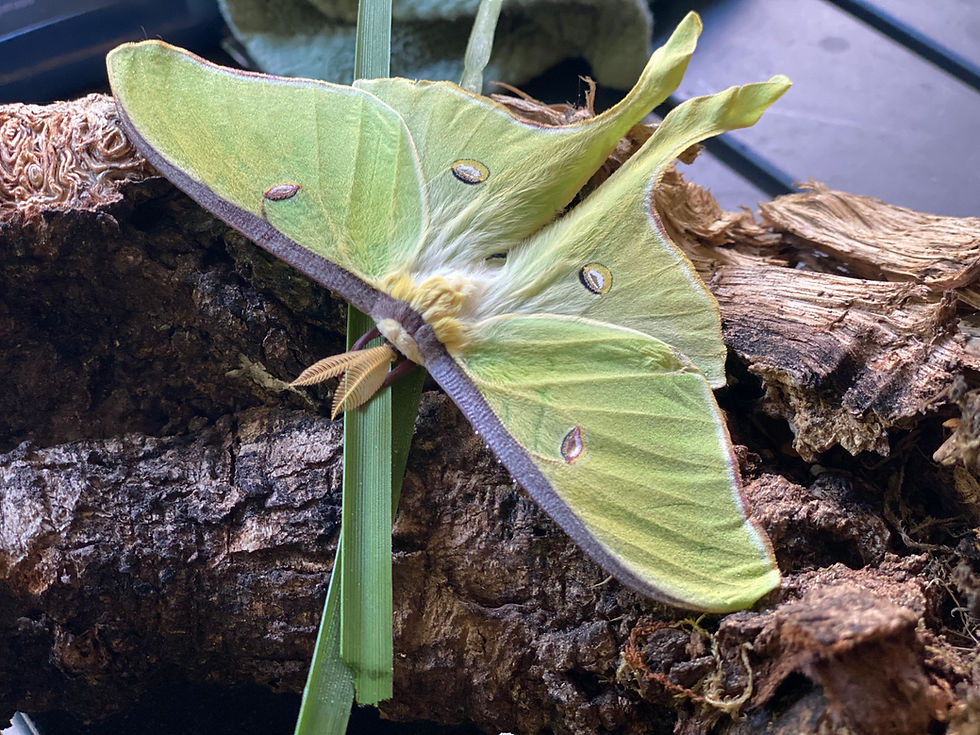Moths: The Pollinators You Didn't Know About
- Brad Owen
- Jun 20, 2023
- 3 min read

All the media hype seems to be focused on bees, and perhaps a few butterflies, as the most important pollinators. For sure, pollinators are critical to us and the environment, with about 80% of flowering plants requiring active pollination by ants, bees, bats, birds, butterflies, moths, wasps and other animals, and about 75% of our crops depending on pollinators. Without pollinators we would starve and have little to look at in the natural world! We all tend to think of bees (specifically honey bees) as the main pollinators of plants. Let’s rethink this!!
The honey bee is the best known pollinator– but what you may not know is that the honey bee doesn’t even belong here in North Carolina. The honey bees we commonly see and raise in hives were actually introduced to North America, and their abundance due to domestication can be blamed for the decline of many true native pollinator bees. Nevertheless, they have become an integral part of our manmade agricultural and horticultural environment, and as such require our attention and support.
However, certain groups of animals seem to have been seriously underrated as pollinators, largely because of their obscurity, and in the case of moths (also bats and some others), they are doing their work in the dark. As someone who has collected moths since 1951, I have seen first hand that many adult moths feed on flowers, much like the butterflies we all have observed in the daytime. Recent research has shown that some moth species have features that capture pollen and facilitate pollination, while others just happen to passively get a “dusting” of pollen as they move from flower to flower. Others, such as the hummingbird moths (also known as sphinx or hawk moths) are specifically adapted to feed on long tubular flowers through the use of the proboscis (their tongue is really like a flexible straw, through which they can suck up various nectars and other liquids), which in one species can extend up to 14 inches! Google it - there are thousands of great pictures of this phenomenon.

Recent research has vindicated my opinion of the value of moths in pollination, and remarkably even gotten the attention of the media - about two weeks ago The Washington post had a feature article exhorting the value of moths as pollinators.
For those of us who think of moths as dull pesky things that fly around our lights (or eat clothes or pantry items), I offer the following tidbits:
Moths are thought to have evolved about 300 million years ago during the carboniferous age, prior to the existence of flowering plants, feeding first on nonvascular plants in their larval stages (caterpillars), and probably not feeding as adults;
butterflies apparently evolved from moths around 100 million years ago in North America, then spread worldwide;
butterflies and moths then further evolved to feed as adults, having co-evolved with flowering plants to feed on the nectar of flowers with a proboscis,
today there are about 160,000 known species of moths, but only about 17,500 species of butterflies;
many moths have just as, or more, colorfully patterned wings (and caterpillars) than butterflies, but due to their flying almost entirely at night, are seldom seen by most people;
there has been a huge and well documented decline in moths and butterflies, especially over the last 50 years or so, signaling alarming ecological trends on our beloved planet!
I plan to have a limited display of some of these remarkable creatures on Saturday, June 24, for our annual Pollinator Week, and hope to see you there! Bring questions, observations, or any moths (or butterflies) you want to talk about or identify.
Brad Owen, PhD., Co-owner, Painters Greenhouse
.png)


